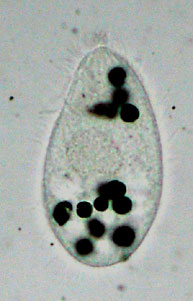
Photo Courtesy of Emily Balf '05'
The animal was photographed using a microscope at 600X. It was "fed" particles of India ink. As the animal fed, the ink particles were collected in food vacuoles that appear as dark spheres inside the cell. By counting the number of vacuoles formed per unit time, it is possible to determined the rate of food vacuole formation.
Click here to view the cilia of a related species of Tetrahymena, T. termophilia. The image was taken on a confocal microscope at 1500X.
Substances that inhibit ciliary action should also inhibit feeding and the rate of food vacuole formation. For this reason, Tetrahymena can be used to study of the effects of potentially toxic substances on ciliary action.
Preparation of cigarette extracts.